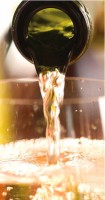Great White Hope
Argentina’s torrontés is set to rival malbec, the country’s standout red varietal
When one thinks of wine from Argentina, the first grape that typically comes to mind is malbec, the country’s prized red varietal. 
But move over malbec, there’s a new grape in town and it’s starting to attract the attention of wine fans worldwide. Poised to become the new “it” white, torrontés (pronounced tor-rhan-tez) is a highly aromatic, uniquely captivating white grape that may soon begin to rival albarino, viognier, pinot grigio and even sauvignon blanc.
Argentina is the fifth-largest wine-producing region in the world, with well over 85 percent of the wine made there consumed within the country. Argentine wines really began to hit their stride in the late 1990s when their product took on a more polished, less acidic style that appealed to wine drinkers in other parts of the world, including the United States. As consumer awareness of Argentine wines continues to grow, fueled in part by an expansion in importing and the immense success of its hallmark red grape, malbec, winemakers are focusing on advancement in winemaking techniques, modernization and producing more consumer-friendly wines. At the same time, wine drinkers continue to seek unique varieties of everyday, easy drinking wines that offer both quality and value. This combination can only lead to success for savvy Argentine winemakers.
While wineries are scattered throughout Argentina running from north to south, the vast majority are located along the western edge of the country, bordering the foothills of the Andes mountain range. This area enjoys well-defined seasons, low humidity, relatively dry growing conditions and irrigation from the channels that run down the mountainside, making it ideal for grape growing. There are six key e-producing regions in Argentina, including Mendoza, the area that is also responsible for 60 to 70 percent of wine production. While torrontés is cultivated in all six areas (Catamarca, La Rioja, Mendoza, Salta, San Juan and Rio Negro), it is primarily grown in the regions of La Rioja, Mendoza, San Juan and Salta.
Sometimes referred to as muscat d’asti, it is believed that torrontés originated somewhere in the Mediterranean, possibly Spain, although its actual birthplace is unknown. It is still being debated exactly when and how torrontés found it’s way to Argentina, but what recent DNA research has proved is that the grape is a member of the malvasia group, which originated in the Eastern Mediterranean. The most likely scenario is that torrontés was brought to Argentina by Spanish colonists. To add to the grape’s uniqueness, DNA testing also shows that there are several subvarieties of torrontés (torrontés riojana, torrontés sanjuanino and torrontés mendocino) of which the first two are related. It is believed that torrontés mendocino is a completely different varietal. While torrontés is also cultivated in Spain and Chile, the most successful examples are coming out of Argentina, where nearly 9,000 hectares are planted with torrontés riojana and about 5,000 to torrontés sanjuanino.
Beautifully aromatic (fresh flowers and fruits leap from the glass), bold and distinct, the torrontés bouquet is a mesmerizing and mouthwatering blend of gewurztraminer, riesling, viognier and pinot gris with common aromas of honeysuckle, lychee, spice, rose petals, tropical fruits, peaches, grapefruit, lemon zest and green apple. While flavors and styles can vary from one region to another and from one producer to another, generally speaking, they are light to medium bodied with crisp, lively acidity and possess exceptional balance. Succulent and textural, they tend to be more flavorful and richer than pinot grigio and sauvignon blanc, but lighter and less unctuous than most chardonnay. Flavors range from citrus, floral and minerals to tropical fruits, exotic spices and dried peaches. Delightfully fresh and lively, most torrontés are best consumed within about two years to retain their zesty, youthful quality.
Distinctive and alluring, torrontés is a refreshingly delicious wine to sip on the porch, at a picnic or poolside. But it also has enough complexity, backbone and acidity to stand up to several types of food including spicy cuisine like Thai or Cajun, grilled or steamed shellfish, broiled or baked fish, light pasta dishes and flavorful salads. Like malbec, Argentina’s white standout is affordably priced with most bottles retailing for less than $15, making them ideal for everyday enjoyment. Now that white wine weather is upon us, be bold, be daring and branch out beyond pinot grigio and chardonnay … you might be pleasantly surprised!

